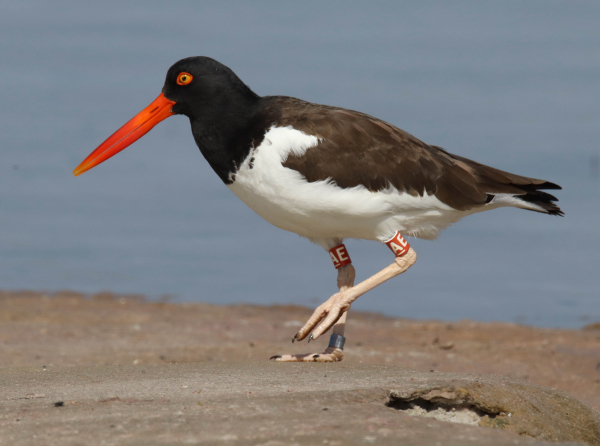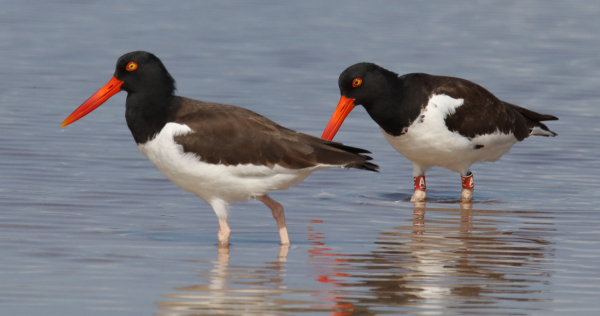
The female American Oystercatcher with the red ‘AE’ bands was photographed earlier in the year by our editor, along with its mate, probably as they were checking out potential nesting sites back in February (photos by Paul Konrad).

|
Exciting news for people in the Tampa Bay–Clearwater area of western Florida: This nesting season, Fort De Soto Park hosted the first American Oystercatcher pair to nest there successfully in more than 20 years. The adult pair and their 3 hatchlings stole the hearts of many park rangers, beachgoers, and birders – including locals and visitors alike – all of whom can take some credit for their survival on the busy park’s beach and coastal wetlands.
The American Oystercatchers provided many insights to their species’ behavior to visitors who encountered them, perhaps most notably the way the banded female chased off any predator that entered the pair’s territory, including crows, gulls, and night herons; and her protective nature continues to impress onlookers while she and her mate overlook the activities of their 3 fledglings.
However, the pioneering pair of oystercatchers couldn’t defend against everything; early in the season a king tide pushed floodwater across the park’s beaches, parking lots, picnic areas, and trails, making everyone concerned for the oystercatcher’s clutch of eggs. Luckily, the oystercatcher nest remained dry in its perfectly positioned location on a slightly elevated point. The pair continued to behave normally, exchanging roles during incubation, feeding, and defense.
The female of the oystercatcher pair was banded as a hatchling in Georgia with a red band with white ‘AE’ letters on each leg, which provided opportunities to identify and follow this individual’s movements. After she flew to the coast of western Florida in 2017, she stayed and paired with an unbanded male. Then, this year they became the first oystercatcher pair to nest in 2 decades at Fort De Soto Park, an impressive haven for Bay area wildlife. With a huge protected area for the oystercatcher pair to select a nesting site, it’s interesting to note that the pair eventually decided to create a nest scrape and lay their eggs in the midst of the busiest beach in the park.
To help protect the American Oystercatchers in this busy section of the beach, Audubon Florida monitors worked closely with members of the park staff and Florida Fish and Wildlife Conservation Commission (FWC) biologists to post the surrounding area and ensure it provided the American Oystercatchers with enough buffer space from potential threats that might include human disturbances, dogs, and predators.
After hatching, it didn’t take long for the pair to lead their 3 tiny “fuzz balls on legs” to a small shallow lagoon to forage. That’s when park rangers established a temporary sanctuary to give the oystercatchers refuge during this important period in the development of the new hatchlings. Now, after the trio of young oystercatchers has fledged, many people ranging from beachgoers, birders, and other interested people can be commended for lending a hand to observe the birds from a distance, and to help inform people about the birds while protecting the areas utilized by the birds.
In addition to the considerable efforts of park rangers, many of whom were quite endeared with the oystercatchers, Florida Audubon volunteers dedicated more than 300 hours to inform about 1,500 people about the American Oystercatchers at the park this season, along with efforts by the Florida Fish and Wildlife Conservation Commission staff. The park’s chief ranger, Dave Harshbarger, said “I’m just so thankful for the partnership with Audubon; of course, we’re all invested here, but we wouldn’t have been able to do it without y’all.”
To refer to the original article published online by Audubon Florida, see Fort De Soto Park Fledges First American Oystercatchers in More than 20 Years | Audubon Florida